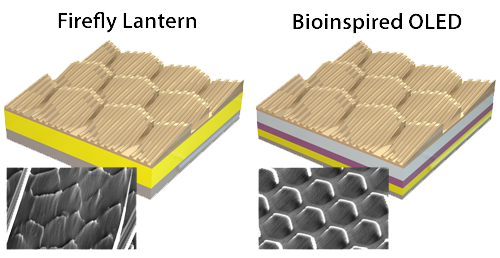Research News: Editors’ Choice
“Editors’ Choice” is a new monthly section in which we recap newsworthy physics results reported in scientific journals. The section complements our coverage of papers from the APS journals by providing an overview of research from the entire physics literature. The articles will be reprinted in our sister publication, APS News.
Shine Bright Like a Firefly
Taking inspiration from fireflies, scientists have fabricated an organic light-emitting diode (OLED) with a complex surface pattern that improves the output efficiency by 61% compared to a smooth surface. Fireflies signal to potential mates by emitting light from a photogenic region on their abdomens, the most efficient bioluminescent organ known. This organ has a specially patterned outer shell, or cuticle, with micrometer-scale tile-like features, as well as nanosized linear ridges. These surface structures help light escape from the cuticle to the air. While previous work focused on a single type of cuticle structure, Jeong et al. (Nano Lett. 16, 2994) have investigated the hierarchical combination of micro- and nanostructures. They imaged the cuticles of male fireflies (Pyrocoelia rufa) and showed that the hierarchical structure reduced internal reflection. The team reproduced the firefly cuticle pattern in a UV resin that they placed on top of an OLED. Compared to a smooth-surface OLED, this bio-inspired device emitted more light and also had a wider angle of illumination.
Turmoil on the Red Planet
Experiments suggest that boiling water may be causing changes on the surface of Mars, as reported by Massé et al. (Nature Geosci. doi: 10.1038/ngeo2706). Recently, spacecraft observations of the planet’s steep slopes have revealed discolorations that lengthen and shorten according to the seasons. Such streaks could indicate flowing water or brines—salty solutions formed from water percolation. But in the thin Martian atmosphere, liquid water is expected to either freeze or evaporate very quickly. To simulate what may be happening on Mars, Massé et al. carried out lab experiments at pressures typical of the red planet (less than 1% of the Earth’s sea-level pressure). They let a small amount of ice melt on top of a sand-covered slope and then watched the meltwater percolate downwards through the sand and boil at the interface between wet sand and air. The boiling water ejected sand grains, forming piles that collapsed, leaving dark-colored streaks reminiscent of those seen on Mars. The results suggest that even modest quantities of boiling water could be a key factor shaping the planet’s surface.
This White Dwarf Isn’t Like the Others
The first white dwarf with an almost purely oxygen atmosphere has been discovered in new data from the Sloan Digital Sky Survey. The oxygenated dwarf is one of about 32,000 in the survey, but its spectrum reveals an atmosphere with a unique chemistry, challenging scientists’ understanding of stellar evolution. As they age, stars with less than 8 to 10 solar masses typically become white dwarfs. These dense, Earth-sized objects form once hydrogen and helium have been largely consumed and can no longer fuel the fusion that counteracts gravity. The remaining hydrogen and helium float to the surface, where they dominate the visible emission spectrum. Kepler et al. (Science 352, 67), however, found a dwarf whose spectrum was dominated by oxygen lines, suggesting the outer layer of hydrogen and helium disappeared as the white dwarf formed. Instead of hydrogen and helium, they saw a mixture of oxygen, neon, and magnesium that is most commonly found in more massive white dwarfs, and trace amounts of silicon that are associated with the formation of neutron stars.
Lunar Iron Points to Nearby Supernova
Researchers studying lunar soil samples have uncovered high levels of an iron isotope consistent with fallout from a nearby supernova about 2 million years ago. Nearby supernovae might be connected with extinctions on Earth. Besides emitting deadly radiation, these events also spew out elements such as , which can settle on planetary bodies within the blast zone. Since this isotope has a radioactive half-life of 2.6 million years, finding high levels of it in a geological sample imply a fairly recent (and close) supernova. The supernova hypothesis— first proposed in 1999—is supported by recent observations of in the Earth’s oceanic crust. But the unworked surface of the Moon is a better record. Fimiani et al. (Phys. Rev. Lett. 116, 151104) obtained lunar soil samples from the Apollo missions. They found the ratio of to total iron was around 1 part in , which is about 10 times higher than the measured background. Cosmic-ray interactions—another possible source of —could not account for this high concentration. (Adapted from the Physics article “Supernova Footprint on the Moon.”)
Theorists Tackle a 750 GeV Bump
A quartet of papers in Physical Review Letters attempts to explain the origin of a 750 GeV signal found last year at the LHC. The observation has generated many theory papers and, if confirmed, would imply the existence of surprising new particles. Three of the papers center around some new 750 GeV bosons: a pion-like boson associated with a new type of strong force (Y. Nakai et al., Phys. Rev. Lett. 116, 151802), a Higgs-like boson that couples to new kinds of fermions (G. Li et al., Phys. Rev. Lett. 116, 151803), or a boson that is the supersymmetric partner of a hypothetical fermion called the goldstino (C. Petersson and R. Torre, Phys. Rev. Lett. 116, 151804). The fourth (W. S. Cho et al., Phys. Rev. Lett. 116, 151805) proposes that the signal is not due to a 750 GeV particle at all, but to some even heavier particles that decay via a cascade to lighter particles along with photon pairs of about 750 GeV. By the fall of 2016, the LHC should have collected enough data to determine whether the hint is a real signal or a statistical fluctuation. (Adapted from the Physics article “Explaining a 750 GeV Bump.”)





